A Brief History of the Volkswagen Transporter1947 An idea first takes shape
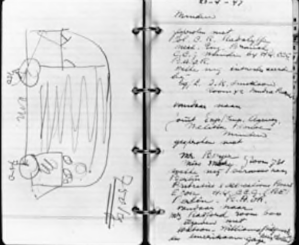
1948 A prototype is developed (with some help from the Beetle)1949 Test. Retest. Success. Transporter is put into production1950 Introducing the KombiThe Kombi is introduced in 1950. The initial Transporter was intended to be purely a delivery type vehicle. While still Spartan in appearance, the Kombi offers seating in the rear compartment for passengers, along with windows down the side of the vehicle. The seats are easily removed for loading cargo. This makes the Kombi the first combination people/package hauler, hence the name “Kombi.” 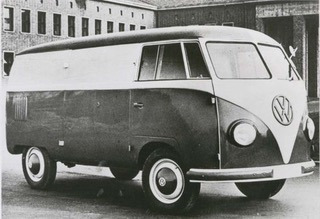
1951 The Samba Bus debuts, and this bus is built for comfort1952 Yes, Germany had their own version of the El Camino 1954 100,000 Transporters and countingThe 100,000th Transporter rolls off the assembly line in Wolfsburg. The engine size is increased, improving horsepower from 25 to 30 horsepower. All models are made available with right-hand drive to increase sales in foreign markets and the postal service.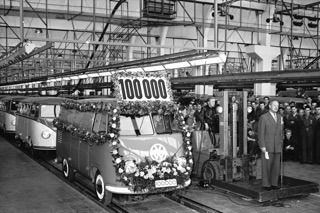
1955 Hydraulic shock absorbers, and so much more
1956 All Oom-pah-pah music at the new Hanover factory. All the time.1958 Now, with a double-crew cab1959 Transporter gets some major smoothness in the shifting department
Safety is increased with the introduction of bullet-shaped flashing indicators on the front of the vehicle. This replaces the old system of side-mounted semaphore signals, which now seem incredibly dangerous and antiquated, even for the time.
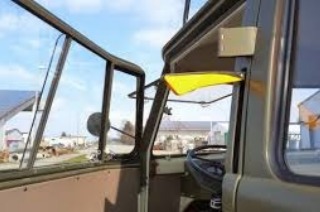 1961 One million Transporters and counting1963 Optional sliding doors, and more improvements1965 Still getting lapped by everything short of an ice cream truck, but not as quickly1966 Buckle up. Seat belts and new electrical system addedOne of the major complaints about the Transporter is finally addressed with the 12 volt electrical system replacing the old and inadequate 6 volt system. Transporters can finally operate at night without their headlights dimming at stop signs. Another safety feature—seat belts—are introduced. 1967 The all-new second-generation Transporter brings new styling and featuresThe first major revision of the Transporter since its inception. The new second-generation Transporter features a revised body shape including a large one-piece front windshield and sliding side doors on all models. Drivetrain changes include a transmission with double-jointed driveshafts and a new 1.6 liter, 47 horsepower engine. The new Transporter is not as aesthetically pleasing as the original bus, but it does feature more interior room and hauling capacity. 1969 Turns out rocket ejector seats aren’t all that “safe”Two safety-related improvements are introduced: a collapsible steering wheel and stronger doors. A third proposed safety improvement—rocket-assisted ejector seats—is rejected due to cost considerations and the existence of overhead power lines. (Just kidding.) 1970 You had me at dual-port cylinder headsThe engine is redesigned to include dual-port cylinder heads, which improves performance to 50 horsepower at 4000 RPM. 1971 Bigger engine. More to love.The engine size is increased to 1.7 liters on the 1971 VW Bus model, with a major (well, relatively) power increase to 66 horsepower at 4800 RPM. 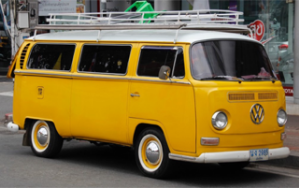
1972 Just don’t forget to lift your legs if there’s a collisionThe automatic transmission is made available on all models except the pickup. An important safety revision is the redesign of the cab floor with a crumple zone. Drivers are still advised to lift their legs in the event of an impending head-on collision. 1973 In other news, front indicators are relocated to side of front grillThe engine is once again enlarged, this time to 1.8 liters, producing 68 horsepower at 4200 RPM. In a minor appearance change made by VW Transporter Design Department to justify their existence to upper management, the front indicators are relocated to either side of the front grill. 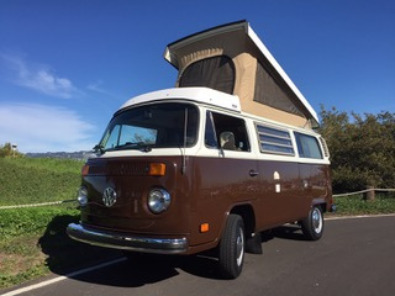
1979 Hello Vanagon!The third-generation Transporter or “Vanagon” is introduced by Volkswagen in 1979. The Vanagon features a complete restyling of both the exterior and interior. Gone is the round shape of the previous two generations of Transporters in favor of a more angular "wedge" shape. The interior is upgraded substantially to bring it up to the level of comfort in modern vehicles. In addition to the body, all other systems are redesigned and improved.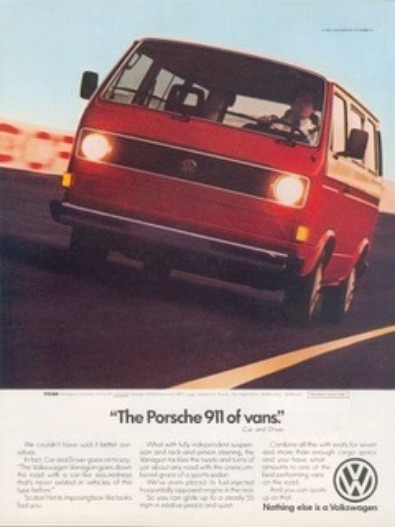
1982 Finally, the WaterboxerWhile other Volkswagen vehicles were now water-cooled, the Transporter had hung on to its air-cooled heritage. No longer. The Transporter now features a water-cooled 1.9 liter flat-four engine, also known as a “waterboxer.” Also available this year, a 1.6 liter diesel engine (and you thought standard Transporters were slow on acceleration). 1986 The Transporter reaches 100 mph (not that you’d want to)The 2.1 liter waterboxer engine is introduced. Highway speeds approaching 100 mph can be attained, but are not recommended. |